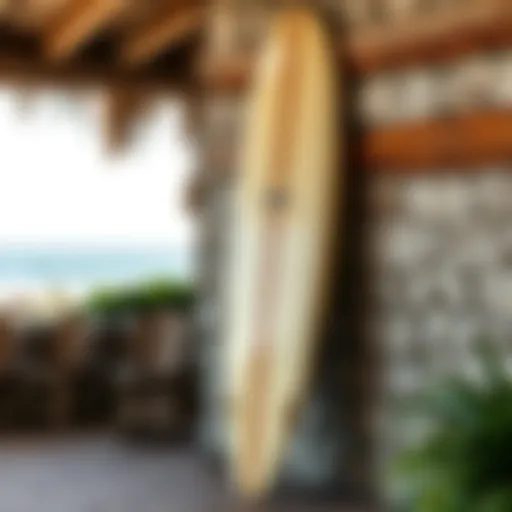Exploring the Rich Landscape of Surf Art
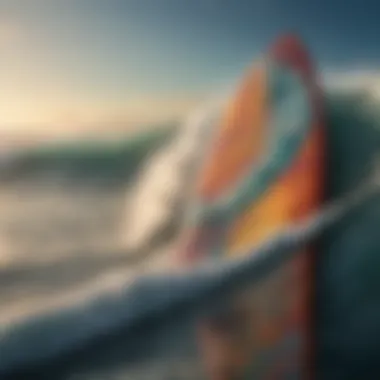

Intro
Surf art is more than just a painting hanging on a wall; it's a vibrant expression of a lifestyle that intertwines with waves, beaches, and the thrill of riding the ocean. Throughout the years, surf art has transformed remarkably, reflecting not only the aesthetics of surf culture but also its ethos and environmental concerns. This article aims to take a closer look at how surf art has evolved, what influences it, and the key players shaping its narrative today.
From the handcrafted designs on surfboards to bold images that grace the walls of galleries around the world, the essence of surf art captures the spirit of adventure. It’s about more than just catching a wave; it’s about harmony with nature, creativity, and community. Surf art serves as a storytelling medium, showcasing tales of riders and waves that inspire the artful pieces people create.
Surf art reflects more than just surfing; it embodies a deep connection to nature, creativity, and community.
In the following sections, we’ll journey through the intricate maze of surfboard technology as the backbone of surf art, explore the necessary techniques for both aspiring and seasoned surfers, and recognize the artists making waves in the community.
The journey into the worlds of innovation and passion that intertwine with surf art will not only enlighten but inspire both surfers and art lovers alike, igniting a respect for nature and creativity.
Prolusion to Surf Art
Surf art embodies more than just vivid colors on canvas; it captures a lifestyle, an attitude, and a way of connecting with the ocean. It is the visual manifestation of the experiences and joys that surfing brings, resonating deeply with those who navigate the waves. This article aims to peel back the layers of surf art, examining its history, evolution, and significance in the broader context of surf culture. Whether you’re a surfer, an outdoor enthusiast, or just someone captivated by the ocean's beauty, exploring this art form offers a fresh perspective on how creativity and nature coalesce.
Defining Surf Art
Surf art can be defined as a creative expression that draws inspiration from surfing, the ocean, and the surrounding lifestyle. It often reflects the vibrant energy of the sea, the emotions tied to riding waves, and the camaraderie within the surf community. From striking paintings that adorn gallery walls to the graphics that grace surfboards, this art form is multifaceted.
In essence, surf art marries artistry and athleticism, inviting us to appreciate the aesthetics of surfing and the stories carried by the tides. Artists from various backgrounds infuse their perspectives into this genre, making it a rich tapestry of ideas and techniques. The creativity behind it can evoke feelings ranging from exhilaration to tranquility, allowing viewers to feel connected to the ocean, even if they remain on dry land.
Historical Context
To appreciate surf art fully, one must understand its historical roots. The origins of surf art can be traced back to the early 20th century, where it began to flourish alongside the growth of surfing culture in places like Hawaii and California. Initial depictions were often simple: illustrations were sketched in magazines, portraying the thrill of riding waves. As surfing gained popularity, particularly in the 1960s, artists began to experiment with bolder styles and techniques, inspired by the counterculture movement of the time.
In this period, surfboards became canvases themselves, as shapers collaborated with artists to paint graphics that spoke to the individual identity of surfers. This relationship between surf culture and art flourished, allowing for a diverse range of styles to emerge.
"In the past, surf art was just an afterthought; now, it holds its own as a statement of individuality and culture."
As we move through the decades, a more global perspective on surf art emerged, influenced by various artistic movements and cultural exchanges. By the 1990s and into the present, surf art has transcended borders, morphing and adapting. It reflects contemporary issues, such as environmental awareness and social issues, making it a vivid reflection of not just surf culture, but the time we live in.
This dynamic evolution sets the stage for a deeper exploration of how surf art continues to inspire and affect the identities of those who embrace the lifestyle.
The Evolution of Surf Art
The realm of surf art is not a stagnant pool but rather a dynamic wave, constantly reshaping itself with influences drawn from both the natural world of the ocean and the evolving culture surrounding it. Understanding its evolution provides a rich backdrop for appreciating its present forms and future potential. The journey of surf art mirrors the progression of surfing itself—a reflection of social changes, technological advancements, and artistic movements that shape and define identities. This section aims to delve deeply into the nuances that have crafted the unique identity of surf art over the decades.
Influences from Surfing Culture
Surfing culture—often portrayed as a lifestyle intertwined with rebellion and freedom—has had a significant impact in shaping surf art. From the very beginning, these artistic expressions emerged not merely as decorations or embellishments but as profound reflections of a way of life. Artists sought to capture the exhilarating essence of riding waves, the thrill of the ocean, and the underlying ethos of camaraderie among surfers. Iconic imagery involving boards, waves, and sun-drenched settings fueled the artistic vision. In many ways, surf art serves as a visual diary of surfing culture, documenting its evolution while showing how surfers see themselves growing amidst their environment.
Decades of Change
The evolution of surf art can be categorized by the defining characteristics of successive decades, each reflecting broader artistic trends and societal changes. This progression can be segmented into four key eras:
1960s: The Psychedelic Edge
The 1960s ushered in an explosion of color and imagination in surf art, driven by the counterculture movement. Artists like Rick Griffin introduced psychedelic elements into their work, utilizing swirling patterns and vibrant colors to resonate with the era's spirit. This era was characterized by a radical departure from traditional forms, embracing bold graphics that melded art with lifestyle. The key feature here was the incorporation of themes from rock music and drug culture, creating visuals that captured the essence of youthful freedom and rebellion. While this approach might not appeal to every aesthetic preference, it successfully resonated with a generation searching for identity and connection through art. The key advantage of this period was its ability to create a culture-shifting dialogue through bold, visual metaphors.
1970s: Minimalism and Function
In stark contrast to the previous decade, the 1970s saw a shift towards minimalism in surf art. A growing appreciation for functionality and simplicity marked this era, emphasizing clean lines and direct representations over elaborate designs. Artists like John Van Hamersveld brought this change into focus. The famous ‘Endless Summer’ poster showcases minimalist yet impactful imagery. Surfers began to appreciate art's utility on their boards, leading to a practical approach: art that not only looked good but also performed well in the ocean. This era's hallmark was clarity and unpretentiousness, which made it an appealing choice for those who sought to connect deeply with their surf experience. The simplicity of this approach remains a relevant aspect of surf art today, inviting a new generation of surfers to appreciate its functional beauty.
1980s: Pop Culture Influence
The sharp characteristics of the 1980s brought pop culture into the fold of surf art. The decade saw powerful influences from television, skateboarding, and youth culture, marking a shift in the visual language used by surf artists. The vibrant styles of artists like Drew Brophy fused surf graphics with skateboard culture, producing lively and diverse imagery. The frequent use of neon colors and bold typography in this era encapsulated the aesthetic of excess and vibrancy characteristic of the time. Not only did this art become aspirational for a youth culture eager for self-expression, but it also marked surf art as a recognized form of popular culture—one that extended beyond the surf scene itself.
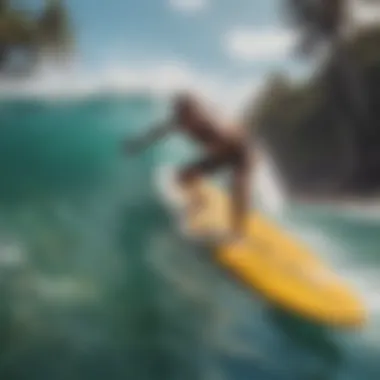

1990s to Present: A Global Movement
In the years since the 1990s, the evolution of surf art has transformed into a global movement, transcending geographical boundaries. The advent of digital media opened new avenues for artists to explore and present their work. Surf artists worldwide began to celebrate their local cultures and landscapes while infusing international influences into their creations. The rise of the internet connected artists and audiences, fostering a community that thrives on diversity and innovation. This expansion democratized surf art, allowing voices from various backgrounds to express themselves. The ongoing dialogue about environmental awareness in the context of surf culture also heavily influences contemporary surf art, with many artists using their platforms to highlight pressing ecological issues. As this movement continues evolving, it promotes an inclusive ethos that reflects surf culture’s rich, global tapestry. The unique feature of this phase is its capacity for collaboration and exchange across cultural lines, enhancing the depth and significance of surf art in the modern world.
"Surf art emerges not just as a visual feast but as a conversation starter—reflecting the history, struggles, and triumphs of a vibrant community."
With each decade contributing uniquely to the depth of surf art, the evolution story is undeniably rich, layered, and ongoing. Understanding these shifts provides essential context for appreciating the vibrancy and complexity of surf art in today's culture.
Notable Surf Artists
The realm of surf art is not just a fleeting trend; it is shaped by tailblazers who have left an indelible mark on both the art world and surf culture. When we talk of notable surf artists, we’re not merely naming individuals; we’re celebrating those who have infused their passion for surfing into their visual expressions, reflecting the soul of the ocean and the thrill of riding a wave. These artists have captured the essence of surf culture through vibrant colors, dynamic forms, and powerful themes.
This section dives into the significance of these artists, focusing on two critical categories: pioneers who set the groundwork for surf art, and contemporary innovators pushing boundaries today. Their works are not just decorations; they are nuanced artworks that tell stories, create dialogues, and inspire generations.
Pioneers of Surf Art
Pioneers, those brave souls that first dipped their brushes into the waters of surf culture, were instrumental in shaping the visual identity of surfing as we know it. Figures like Dogtown’s Z-Boys and Rick Griffin are often mentioned in hushed tones of reverence.
Rick Griffin, for one, is known for his psychedelic and irreverent poster designs that captured the spirit of not only surfing but also the surf-rock music scene of the 1960s. His intricate artworks, laced with vivid colors, reflect a unique blend of surf and counterculture, positioning him as a linchpin in the evolution of surf art.
Another noteworthy pioneer is Dale Velzy, who began his career crafting surfboards before shifting his focus to art. His designs didn’t just adorn surfboards; they captured the very ethos of the surf lifestyle, blending craftsmanship with artistry. Dale's art continues to inspire aspiring artists, reminding them that the ocean serves as a perfect muse, waiting to be interpreted.
"Art is the most beautiful of all lies, and in surf art, truth emerges from the waves."
These pioneers laid the groundwork, allowing contemporary artists to explore new ideas and mediums while staying connected to their surfing roots.
Contemporary Innovators
In a world where surf art continues to morph and adapt, contemporary innovators are key. Their works reflect diverse influences and techniques, often intertwining with digital technology and environmental advocacy. Artists like Tyler Warren and Justine Williams are leading the charge in this dynamic scene.
Tyler Warren bridges the traditional and contemporary, crafting surfboards that are as much about aesthetics as they are about functionality. His approach prioritizes sustainability alongside style, echoing modern surfers' values.
On another front, Justine Williams merges her love for surfing with photography, capturing candid moments of surfers that reveal the raw essence of the sport. Her imagery not only emphasizes the thrill of the ride but also highlights the delicate ecosystems that surfers cherish.
Innovators like these often collaborate with brands, nurturing a culture where art meets commerce—a fusion that benefits both the artist’s platform and the surf community.
In today’s world, where the future of surf art hangs in a precarious balance with commercial interests and environmental concerns, it's vital to recognize how notable surf artists, both past and present, advocate for a harmonious relationship between art, surfing, and nature. Their journey signifies the ongoing evolution, rich history, and critical importance of surf art in shaping identities and preserving surf culture.
Mediums and Techniques
The realm of surf art is as diverse and fluid as the ocean itself. Its mediums and techniques play a crucial role in shaping artistic expressions and communicating the vibrant culture surrounding surfing. Understanding these elements provides insight into the surf community’s creativity, and the methods artists use to capture the spirit of the waves. From traditional methods to new-age innovations, each medium offers unique benefits and considerations that shape how the narrative of surf art is told.
Painting and Illustration
Painting and illustration have long been cornerstones in the world of surf art. These mediums allow artists to express the adrenaline of surfing and the serene beauty of ocean life on a canvas. Often characterized by vibrant colors and dynamic compositions, they enable a deep exploration of themes such as adventure, freedom, and nature.
For instance, the use of acrylics and oils grants artists the power to create striking seascapes or intricate designs on surfboards, uniting functionality with artistic vision. Frequently, illustration serves as a means to convey personal stories or cultural tales, often echoing the experiences of surfers from diverse backgrounds.
Here are a few notable considerations regarding painting and illustrations:
- Technique Variation: Techniques can vary widely, from bold brushstrokes to delicate ink work.
- Cultural Symbolism: Patterns and symbols often reflect the local surf culture's values and beliefs, turning each piece into a story.
- Sustainability: Many artists are now turning towards eco-friendly paints and sustainable practices as surf culture increasingly embraces environmental responsibility.
Photography
In a world where the fleeting moment captures all—photography is essential in surf art. It’s not merely about freezing time but expressing the thrill and passion associated with surfing. Each photograph can be a powerful narrative, showcasing dramatic waves, challenging ridges, or subtle moments of internal reflection amidst nature’s extravagance.
Photographers like Clark Little are renowned for their stunning underwater shots, evoking feelings of intimacy with the ocean that often goes unnoticed by the casual observer. Such visuals create awareness about the balance between adventure and nature, drawing viewers into a world many may not have dared to explore.
Important aspects to note:
- Technical Skills: Mastery of timing, lighting, and framing is vital to producing compelling images.
- Storytelling: Each photo tells a story—whether it’s the camaraderie of surfers out in the water or a lone rider challenging a massive swell.
- Virtual Sharing: The rise of social media platforms has transformed how surf photography is consumed, inviting everyone from professionals to enthusiasts to share their perspective on the surf world.
"A photograph is worth a thousand words, but for a surfer’s experience, it’s worth a thousand waves."
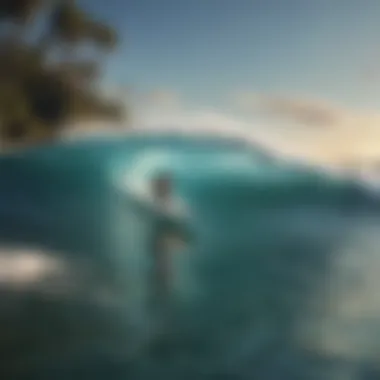

Digital Art and Motion Graphics
As the art world evolves, digital art and motion graphics have emerged as powerful tools for artists in the surf culture. This medium allows for unlimited creativity and provides a platform for mixing various styles and techniques. Digital art can range from 2D illustrations to complex 3D animations that capture the fluidity and movement intrinsic to surfing.
With programs like Adobe Illustrator and Procreate, artists can produce both surreal imagery and realistic designs, catering to eclectic tastes. Motion graphics further extend these creations, often used in surf films and promotional content, drawing viewers into the kinetic energy of the sport.
Key points to consider:
- Accessibility: The digital medium has democratized art creation, making tools and tutorials available to anyone with an internet connection.
- Interactive Experiences: Digital platforms often allow for interactive elements, making the viewing experience more engaging.
- Environmental Impact: As with traditional mediums, there are growing discussions around the environmental footprint of digital art creation, including the energy consumption of digital devices.
Through understanding the various mediums and techniques, we begin to comprehend the depth of surf art’s impact not only on the artists but also on the audiences and communities involved. Each medium has its unique narrative, and together they contribute to the rich tapestry that is surf culture.
Surf Art Festivals and Exhibitions
Surf art festivals and exhibitions are not just gatherings; they’re vibrant cultural celebrations that bring together artists, enthusiasts, and the broader community. They serve as a canvas showcasing the creative expression that is deeply intertwined with surfing culture. Through these events, the elements of surf art—its evolution, innovation, and impact—come to life, fostering appreciation and understanding among diverse audiences.
Global Events Showcasing Surf Art
On the international stage, various festivals exhibit surf art, each highlighting unique aspects of the culture. Events like the Festival of Surfing in Hawaii or the Portugal Surf Film Festival blend art, film, and music, showcasing both established and up-and-coming surf artists. During these festivals, one can witness live art performances, interactive installations, and even workshops where attendees can learn about techniques in surf art. These gatherings emphasize the connection between art and the ocean, promoting a sense of community and shared passion among surfers and artists alike.
Such festivals do more than just display artwork; they often include talks by renowned artists, surfboard shaping demonstrations, and discussions on the emerging trends in surf art. These activities generate an atmosphere of learning and inspiration, allowing attendees to experience firsthand how art reflects the spirit of surfing.
A notable mention is the San Diego Surf Art Festival, where artists not only exhibit pieces but also sell merchandise, creating a dynamic environment for commerce that supports local artists. Events like these offer opportunities for networking and collaboration, pushing the envelope of what surf art can represent in the future.
Local Community Initiatives
Local community initiatives further bridge the gap between surf art and grassroots movements. Many surf towns host small-scale art showcases and competitions, inviting local talent to display their work. These initiatives often target newcomers and foster local engagement. Gang of artists gather in venues like cafes or community centers, showcasing their pieces and sharing their stories. This personal touch creates an intimate environment where surf art becomes a shared experience rather than just an exhibition.
Moreover, local surf art festivals often focus on environmental themes, reflecting the global consciousness of today. Many artists use recycled materials or paint ecological messages into their works. By reinforcing the ties between surfing and environmental advocacy, these events encourage dialogue on sustainability within the surf culture. This resonates with attendees who recognize the significance of protecting the very waters that inspire the art.
In sum, surf art festivals and exhibitions serve as crucial platforms for both artistic expression and environmental advocacy. By attending these events, visitors not only engage with the art but also become part of a larger conversation about surfing culture, identity, and responsibility. Ultimately, they highlight the profound influence of surf art as a medium of expression and activism, defining a vibrant culture that constantly evolves.
"Surf art is not just about aesthetics; it's a reflection of the lifestyle and the environmental challenges we face."
Through these festivals, the spirit of surfing is celebrated, showcasing how art captures the waves, the emotions, and the culture of the surfers' journey.
The Role of Surf Art in Environmental Advocacy
The relationship between surf art and environmental advocacy is not merely a passing trend; it has transformed into a core facet of both the artistic expression and the surfing culture. Artists have taken it upon themselves to shine a spotlight on the fragility of marine ecosystems, using their creativity to communicate urgent environmental messages. This section aims to unravel how surf artists are blending their passion for the ocean with their commitment to preserving it, weaving a narrative that resonates deeply with the global surfing community.
Awareness and Activism
Awareness is often the first step in advocating for change. Surf artists have used their canvases to challenge complacency regarding ocean pollution, climate change, and habitat destruction. Through striking visuals that often evoke the beauty of the sea juxtaposed with its degradation, artists encourage both surfers and the general public to reflect on their impact on the environment.
Some artists focus on representing specific issues:
- Plastic waste: Many surf artists create pieces that depict the dangers of plastic pollution, portraying sad scenes of marine life entangled in debris, which effectively drives home the point of how our negligence affects the natural world.
- Rising sea levels: Imagery illustrating the encroaching ocean can provoke thought about climate change and its consequences, stirring a sense of urgency among viewers.
The role of surf art in raising awareness does not stop at mere representation. Many artists engage in activism, attending or organizing events that aim to educate the public about pressing environmental issues. This outreach is necessary to mobilize action, promoting communal efforts in beach cleanups, awareness campaigns, and funding drives for organizations focused on marine conservation.
"Art is not a mirror to reflect reality, but a hammer with which to shape it."
– Bertolt Brecht
Collaborations with Non-Profits
Collaborations with non-profit organizations form another significant aspect of surf art's environmental advocacy. These partnerships leverage the popularity of surf culture, combining it with the resources and reach of environmental groups. By aligning with well-known surf artists and filmmakers, non-profits amplify their messages, utilizing art's emotional appeal to engage a wider audience.
- Examples of Notable Collaborations:
- Surfrider Foundation: Many surf artists have designed limited edition prints or merchandise. Profits often support beach cleanups and campaigns aimed at protecting coastlines.
- Ocean Conservancy: Collaborations here have focused on raising awareness about marine debris through various artistic initiatives, including murals and installations that call attention to plastic waste.
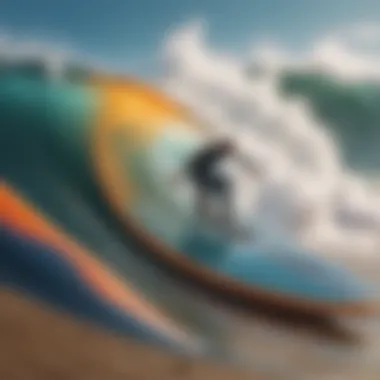

These collaborations not only provide artists with a platform but also expand the reach of these organizations, allowing them to draw in those who might not normally engage with environmental issues. By intertwining art and activism, the surf community is able to craft a narrative that encourages sustainability, one stroke at a time. The art becomes a conversation starter, stimulating thought and, hopefully, leading to positive environmental practices among surfers and enthusiasts alike.
Commercial Aspects of Surf Art
The interaction between art and commerce can make or break the fortunes of many creative endeavors, and surf art is no exception. As the surf culture expands and evolves, the commercial aspects of surf art are increasingly significant. Not only do they provide financial support for artists and galleries that celebrate this vibrant genre, but they also enhance the visibility of surf art in popular culture. Understanding these commercial dimensions can help appreciate how surf art thrives in both artistic and financial realms.
Surf Art Merchandise
Surf art merchandise represents a melting pot of creativity and entrepreneurship. The variety here is staggering; you can find everything from clothing items emblazoned with stunning surf-inspired prints, to home décor that captures the essence of the ocean. Items can include:
- T-shirts and Hoodies: Featuring designs from well-known surf artists or even local talents, these items turn casual wear into a canvas for art.
- Posters and Prints: Often available at affordable prices, they allow fans to showcase their love for surf culture in their homes or workspaces.
- Accessories: Think bags, hats, and surfboard decals that are visually appealing and functional, expressing individual styles.
- Art Books: These can range from anthologies of various artists to specific collections focusing on iconic surf moments.
- Eco-Friendly Products: With a growing emphasis on sustainability, many surf art merchandise items are made from recycled materials or produced with less environmental impact.
The commercialization of surf art isn’t simply about profit; it serves a crucial role in promoting artistic expression. The deeper the connection between surf culture and art, the more momentum there is for creating unique merchandise.
More than just products, merchandise serves as a bridge between artists and their audience. When surfers sport replications of this artwork, they become living endorsements, creating a community of like-minded individuals who appreciate the artistry and culture behind their choices. Furthermore, social media has allowed for a grassroots-level marketing machine, where fans share their favorite finds, expanding the reach of artists beyond traditional galleries.
Brand Collaborations
Brand collaborations have become a cornerstone of surf art's commercial landscape. Think about the brands in surf wear, equipment, or lifestyle that partner with surf artists to produce limited edition items. These collaborations not only elevate the brand but also offer artists a larger platform for their work. Here are a few elements that highlight the significance of these partnerships:
- Mutual Benefits: Brands gain authenticity and a unique identity by aligning with surf artists. Artists, in turn, get the clout and financial backing to produce larger endeavors.
- Event Promotion: Many collaborations result in organized events such as pop-up galleries or surf competitions that celebrate the integrated culture. This creates an atmosphere ripe for awareness-building.
- Social Media Campaigns: Collaborations are often launched with marketing campaigns that utilize stunning imagery and storytelling from the artists themselves, driving traffic and engagement.
- Sustainability Focus: Brands are increasingly looking to collaborate with artists who are eco-conscious. Initiatives that support environmental advocacy resonate well with the community and create a positive image for both parties involved.
By harnessing the power of art, brands can create narratives that foster deeper connections with consumers, especially in a culture fueled by personal expression and discovery.
The Future of Surf Art
The landscape of surf art is on the brink of evolution, mirroring the waves of change that characterize the sport itself. As we look ahead, the conversation around surf art embraces innovation, technology, and a broader scope of cultural relevance. This section aims to peel back the layers of what’s coming down the pipeline for surf art, exploring the unique trends emerging in today's rapidly changing world. Understanding these advancements not only sheds light on the artistic direction but also emphasizes the role of surf art in our society.
Emerging Trends
Art, much like the sea, is fluid and responsive to the world around it. One critical trend we’re seeing is the rising focus on sustainability within surf art. Artists are increasingly using biodegradable materials and engaging in practices that minimize environmental harm. This shift is a conscious attempt to align more closely with the surf community’s advocacy for ocean health and environmental preservation.
- Community-driven projects: Artists are stepping beyond traditional galleries, opting to organize local workshops and community-driven art interventions. This grassroots approach fosters a more inclusive atmosphere and encourages the public to take part in the creative process, transforming art from a solitary experience into a collective celebration.
- Artistic showcases at surf competitions: Surf events are becoming hotspots for showcasing art, merging sports with creativity. It’s common now to find live art installations at major surf competitions, promoting exposure for underground artists while enriching the competition environment.
Furthermore, social media platforms, especially Instagram, are playing a significant role in shaping trends. Artists can easily display their work and connect directly with admirers, effectively breaking down the barriers of conventional art distribution.
"The art that resonates today is not just in galleries but on our screens. It’s how we engage, inspire, and collaborate that leads to the coolest surf art of tomorrow."
The Digital Frontier
The digital realm is becoming a powerful tool for surf artists, transforming how they create and share their work. Virtual reality, augmented reality, and other advanced technologies are enabling artists to craft immersive experiences that were previously unimaginable. For instance, using virtual reality, a viewer could step into a digital surf paradise and interact with surf art in a novel way.
- Animation and Motion Graphics: Not solely limited to screens, this contemporary method enables artists to animate their illustrations, adding depth and movement to their pieces. The engaging visual storytelling can captivate audiences and draw them closer to the themes and concepts being portrayed.
- NFTs (Non-Fungible Tokens): This new platform for ownership in the digital world allows surf artists to sell their works as unique digital assets. This blend of art and technology is opening doors for artists to gain access to global markets, providing them with financial opportunities while ensuring the provenance of their creations.
As surf art moves forward, it is essential to realize these developments do not simply replace traditional mediums. Instead, they augment the conversation, opening new avenues for expression. As surfers and lovers of art, embracing these changes allows us to cultivate a richer, more diverse artistic community that reflects a shared passion for both creativity and the ocean.
Closure
The journey through the vibrant expressions of surf art reveals much more than mere aesthetics; it showcases a rich tapestry woven with history, culture, and creativity. Surf art serves not only as decorative appeal but also as a powerful medium of social commentary and environmental advocacy. By understanding its significance, we can appreciate how these artistic endeavors echo the very spirit of surfing—a pursuit that embraces freedom, nature, and community.
Reflecting on the Journey of Surf Art
Surf art has come a long way, morphing through varying styles and influences. What began as simple designs on surfboards has transformed into an extensive genre that spans multiple forms, including painting, photography, and digital creations. The growth can be attributed to key artists and movements that challenged the norms.
The radical transitions during the 1960s and 1970s pushed the boundaries, and the psychedelic colors showcased the high energy and counterculture vibes of the era. Each decade brought in its unique flavor, molding surf art into a comprehensive dialogue of cultural shifts. This journey reveals patterns where creativity meets surf culture, offering insights into both the challenges and the triumphs faced by artists.
The Lasting Impact on Surf Culture
Surf art’s influence reaches far beyond visual representation; it deeply embeds itself within the fabric of surf culture. Artists like Ed Roth, whose designs were pivotal in shaping the aesthetic direction of surfboards, signify how creativity can captivate and inspire a community. This connection to art emphasizes a sense of identity among surfers, where each design not only decorates but also tells stories that resonate.
Moreover, the environmental advocacy sparked by surf art cannot be overlooked. Many artists collaborate with environmental groups, using their platforms to promote ocean conservation. Their art creates awareness, reminding us that protecting the ocean is critical for the future of both surf culture and the planet.
"Art helps us see the invisible connections between surfing and the environment. Through visual storytelling, surf artists promote awareness while celebrating their passion for waves."
As we look to the future, the evolution of surf art will likely continue to inspire and empower communities, capturing the nuances of a culture that thrives on creativity, environmental stewardship, and the relentless pursuit of waves.



